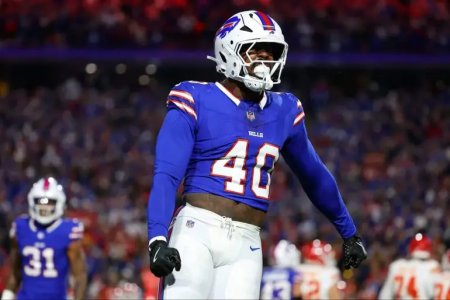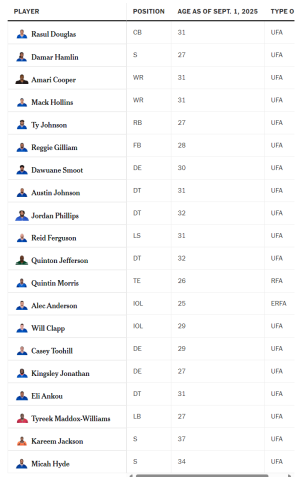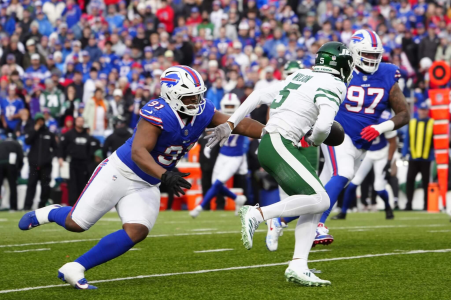
Bills 2025 offseason: Analyzing salary cap, roster moves Buffalo could make
The Bills are in a much different situation than they were last year.

Although it isn’t what the Bills would have liked to be doing this week, the offseason planning in Orchard Park is well underway. It shifts into Brandon Beane season for the Bills as he attempts to sculpt the 2025 roster to be the one that finally becomes the Super Bowl-winning team he’s hoped for since he arrived in 2017.
As has been the trend for several offseasons, the Bills must undergo strategic cap management to improve their roster next year and in future seasons. How does it look this offseason, and what moves make the most sense to help them accomplish everything?
Here is a full-scale examination of where the Bills’ offseason must begin.
Analyzing the roster
Before we dive into what the Bills could or couldn’t do, we have to take a wholesale look at the roster and their free agent list. The striking realization is that the vast majority of the Bills’ 2024 roster will be back in 2025. Only three starters and two other sizable contributors aren’t under contract next season. The starters are cornerback Rasul Douglas, safety Damar Hamlin and wide receiver Mack Hollins. The other two contributors are wide receiver Amari Cooper and running back Ty Johnson, with Cooper listed as a non-starter because Hollins out-snapped him almost weekly.
2025 Bills free agents

If they re-sign none of those top five free agents, the only two absolute starting roles they would need to replace externally would be at wide receiver and cornerback. Hamlin is a starter, though if they moved on, that would pave the way to a starting job for Cole Bishop, and that was likely how they wanted things to go, given their draft investment in Bishop. They potentially have some other depth and special teams players to replace, but they could get most back on a relatively manageable deal. By and large, the Bills are in a great place as far as their 2025 starting lineup is concerned, in the sense that they don’t have to replace a starting spot because of a player being out of contract.
What does their cap space look like heading into the offseason?
Due to some postseason contract adjustments and incentives getting hit, the Bills’ cap space looks worse than it did even a week ago. It all depends on what the NFL will set for the 2025 salary cap, but should it closely follow the OverTheCap.com projection of $272.5 million, they have the Bills projected at $12.6 million above that limit. That means the Bills have some work to do to get cap-compliant before they even think about hitting the free-agent market. It pales in comparison to how much they had to do last off-season to get under the cap, but steps will need to be taken in the same manner.
Logical moves to clear cap space
The Bills have a good news, bad news situation when it comes to the moves they could make to get cap-compliant. The good news is that to get the cap space they need, they won’t need to eliminate much from their AFC Championship Game team to do it. They don’t have near the number of contracts they did last offseason to cleanly cut for cap space. The bad news is, while likely keeping the players, most of the moves they could make will wind up kicking the can down the road into future years of cap space. It’s a short-term win vs. a potential long-term loss situation, but the Bills are painted into that corner this offseason. Here are the moves that make the most sense, and you’ll sense a theme.
DE Von Miller takes a pay cut or is released
It’s an option with two doors, but because Miller isn’t owed any guaranteed money, both the team and player have a little leverage in the situation. Miller has a 2025 dead cap charge of $15.4 million, but the contract has no guaranteed money on it. It could become a mutually beneficial decision between both parties to negotiate a pay cut for Miller that would yield the $8.4 million in cap savings this year they would get by cutting him, if not more to reflect the truest form of his value. On the field, at the very least, Miller proved to be a good situational pass rusher and can capably continue in his 15-25 snap role that he held in 2024, despite turning 36 in March. If Miller does not agree to that type of pay cut, it’s very simple — the Bills should cut him and get the $8.4 million in cap space.
Another option would be for the Bills to cut Miller with a post-June 1 designation, and while that would eventually yield more cap space this year than a standard cut, there are a couple of problems. The first is the timing issue because if the Bills were to use that designation on Miller, the $17.4 million in cap space for 2025 would not become available until June 1, and Miller’s current spot on the cap sheet would hold until then. On top of that, the Bills would still have a $6.4 million dead cap charge for Miller for 2025 and still the $9 million in 2026 that they’d have anyway if they had kept Miller this year and cut him after next season. For this scenario, the Bills wouldn’t have the player or the cap space for offseason maneuverability while still accruing the massive dead cap charge awaiting in 2026.
Restructure QB Josh Allen’s contract
As Allen remains in the prime of his career for the foreseeable future, maximizing their overall cap space flexibility with him on the roster is vital. So, as is a time-honored tradition since Allen signed his contract, the Bills should continue to restructure his deal by converting all but the veteran minimum of his $14 million base salary in 2025 into a prorated signing bonus. The only difference this time is that they would add a void year for 2029 since only four years remain on Allen’s current deal, and you can prorate a signing bonus up to five years. By taking those measures, the Bills could save $10.2 million on this year’s salary cap, which only adds an extra $2.6 million per year onto his cap charges through the remainder of his deal. While a contract extension would yield savings for 2025, quarterback deals take an extended amount of time to put together and are overwhelmingly complicated as opposed to any other position. Due to a quick track to March 12, the Bills should just restructure Allen’s deal and begin the negotiations to have the extension help 2026 the most, when Allen would have a $66 million cap hit after restructuring his 2025 base salary.
Ed Oliver is a prime candidate for contract restructuring after Josh Allen and Von Miller’s contracts are addressed. (Gregory Fisher / Imagn Images)
Restructure DT Ed Oliver’s contract
Once you get past the obvious ones in Miller and Allen, the next contracts to target for restructures are ones for players that the team expects to be on the team for the next 2-to-3 years, at least. Ed Oliver is the most impactful, as he carries the third-highest cap hit on the team, he’s signed through 2027 and turned only 27 years old in December. Converting most of his $13.75 million base salary into a prorated signing bonus will save $8.33 million on this year’s cap without adding any void years. More importantly, even with the move, the Bills can still get out of Oliver’s deal in 2027 with savings if they choose to.
Restructure LT Dion Dawkins’ contract
Dawkins isn’t going anywhere in 2025, but the team also has a pretty clear window to get out of his deal in 2026, 2027 or later with a bunch of savings if they’d like to. Dawkins has a base salary of $11.1 million in 2025 along with a $2 million roster bonus, and with five years attached to his deal currently, they would be able to save $9.43 million on this year’s cap by converting it to a prorated signing bonus. And if they wanted to move on next offseason, the Bills could still save over $4 million even with this move. I’d guess Dawkins will likely be around through 2026 at least, and would still have $11.6 million in potential cap savings to cut him in the 2027 offseason while doing this restructure.
Restructure TE Dawson Knox’s contract
The Bills signed Knox to a long-term deal and still have Dalton Kincaid on the roster, but the franchise raved about Knox’s impact on the team structure and his day-to-day leadership. He also served as the starting tight end this year over Kincaid, and Knox is only 28 years old. It’s more likely that he plays out his contract through 2026 than moving on from him during their Super Bowl window. That makes him a clear restructure candidate, and he would save them nearly $6 million on this year’s cap by doing the simple base salary to prorated signing bonus conversion. Given his lack of receiving production, this might not be the most popular move, but it might also be a no-brainer inside the building.
Restructure C Connor McGovern’s contract
In his first year as the starting center, McGovern was excellent and is still only 27. He’s entering the final year of his contract in 2025, and could be an extension candidate. If they hold off on that to see how 2024 fifth-round pick Sedrick Van Pran-Granger develops this season, McGovern has an easy contract to convert into a prorated signing bonus. He already has two void years on his deal, a $5.35 million base salary and a $1 million roster bonus. The Bills can save $3.82 million on this year’s cap to restructure McGovern.
Restructure NCB Taron Johnson’s contract
Still only 28 years old and clearly in his prime, Johnson will likely be in Buffalo for at least the next two years, if not all three remaining on his deal. He already has two void years on his deal, too. When converted and spread out over five years, Johnson’s $5.2 million base salary adds only an extra $789,000 to each of the remaining four cap years, saving the Bills almost $3.2 million in 2025.
Moves they should try to stay away from
Restructuring WR Curtis Samuel’s contract
While they could get $3.77 million in savings to restructure his deal, it would create a dead cap charge of over $7 million in 2026 to get out from the deal. Unfortunately for them, despite his lack of impact in 2024, they might just need to bite the bullet and keep him on his contract as is because he has $5.91 million already guaranteed for 2025.
Restructuring DT DaQuan Jones’s contract
Jones is 33 years old and already has a dead cap charge of $3.7 million in 2026 due to the void years on his deal. Since his re-signing chances are lower, converting his base salary to a prorated bonus would harm their 2026 cap outlook.
Restructuring LB Matt Milano’s contract
Milano has meant a lot to the Bills over the years, but with all his injuries and him turning 31 in July, it would be unwise to take their flexibility to get out of his contract in 2026 for some short-term cap relief. Milano is also a post-June 1 cut designation candidate with no guaranteed money owed. He played well enough down the stretch to justify keeping him this year, but his nearly $10 million non-guaranteed owed, which could help them with their various extension candidates, could make them think twice about keeping him in 2025.
Final thoughts
If the Bills were to make all the logical base salary conversions, they would be sitting with nearly $37 million in cap space. They could also do them on a need basis based on where their offseason takes them, rather than doing all of them at once. Miller, Allen and Oliver are the likely starting point, which would get them to $14.3 million in cap space. The Bills have plenty of logical cap flexibility this offseason, which they did not have in 2024. Any moves, regardless of size, are on the table as they try to chase a Super Bowl win. However, they must be cognizant of Christian Benford, Greg Rousseau, James Cook, Khalil Shakir and Terrel Bernard all becoming free agents after the 2025 season. That is the undercurrent of all of their upcoming offseason maneuvering.

